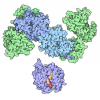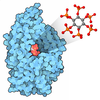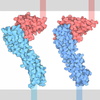+ Open data
Open data
- Basic information
Basic information
| Entry | Database: PDB / ID: 8s0i | ||||||
|---|---|---|---|---|---|---|---|
| Title | A fragment-based inhibitor of SHP2 | ||||||
 Components Components | Tyrosine-protein phosphatase non-receptor type 11 | ||||||
 Keywords Keywords | SIGNALING PROTEIN / protein tyrosine phophatase / SH2 domain / autoinhibition / allostery | ||||||
| Function / homology |  Function and homology information Function and homology informationnegative regulation of cortisol secretion / intestinal epithelial cell migration / microvillus organization / negative regulation of growth hormone secretion / genitalia development / atrioventricular canal development / negative regulation of cell adhesion mediated by integrin / STAT5 Activation / Co-inhibition by BTLA / Netrin mediated repulsion signals ...negative regulation of cortisol secretion / intestinal epithelial cell migration / microvillus organization / negative regulation of growth hormone secretion / genitalia development / atrioventricular canal development / negative regulation of cell adhesion mediated by integrin / STAT5 Activation / Co-inhibition by BTLA / Netrin mediated repulsion signals / negative regulation of neutrophil activation / cerebellar cortex formation / positive regulation of hormone secretion / regulation of protein export from nucleus / Interleukin-37 signaling / positive regulation of lipopolysaccharide-mediated signaling pathway / positive regulation of ossification / Signaling by Leptin / MET activates PTPN11 / hormone metabolic process / Regulation of RUNX1 Expression and Activity / negative regulation of chondrocyte differentiation / Signal regulatory protein family interactions / face morphogenesis / ERBB signaling pathway / platelet formation / triglyceride metabolic process / megakaryocyte development / negative regulation of type I interferon production / organ growth / Interleukin-20 family signaling / Interleukin-6 signaling / PI-3K cascade:FGFR3 / Co-inhibition by CTLA4 / Platelet sensitization by LDL / STAT5 activation downstream of FLT3 ITD mutants / peptide hormone receptor binding / PI-3K cascade:FGFR2 / PI-3K cascade:FGFR4 / PI-3K cascade:FGFR1 / MAPK3 (ERK1) activation / Prolactin receptor signaling / neurotrophin TRK receptor signaling pathway / regulation of cell adhesion mediated by integrin / regulation of type I interferon-mediated signaling pathway / MAPK1 (ERK2) activation / platelet-derived growth factor receptor signaling pathway / PECAM1 interactions / Bergmann glial cell differentiation / inner ear development / peptidyl-tyrosine dephosphorylation / non-membrane spanning protein tyrosine phosphatase activity / positive regulation of intracellular signal transduction / phosphoprotein phosphatase activity / Regulation of IFNA/IFNB signaling / RET signaling / Interleukin-3, Interleukin-5 and GM-CSF signaling / PI3K Cascade / Co-inhibition by PD-1 / fibroblast growth factor receptor signaling pathway / positive regulation of insulin receptor signaling pathway / GAB1 signalosome / ephrin receptor signaling pathway / regulation of protein-containing complex assembly / Regulation of IFNG signaling / Activated NTRK2 signals through FRS2 and FRS3 / GPVI-mediated activation cascade / FRS-mediated FGFR3 signaling / Signaling by CSF3 (G-CSF) / cell adhesion molecule binding / negative regulation of T cell proliferation / Signaling by FLT3 ITD and TKD mutants / T cell costimulation / FRS-mediated FGFR2 signaling / FRS-mediated FGFR4 signaling / FRS-mediated FGFR1 signaling / hormone-mediated signaling pathway / Tie2 Signaling / phosphotyrosine residue binding / protein-tyrosine-phosphatase / FLT3 Signaling / homeostasis of number of cells within a tissue / Downstream signal transduction / positive regulation of mitotic cell cycle / axonogenesis / protein tyrosine phosphatase activity / positive regulation of interferon-beta production / protein tyrosine kinase binding / cellular response to epidermal growth factor stimulus / DNA damage checkpoint signaling / Activation of IRF3, IRF7 mediated by TBK1, IKKε (IKBKE) / integrin-mediated signaling pathway / positive regulation of D-glucose import / insulin receptor binding / Negative regulation of FGFR3 signaling / Negative regulation of FGFR2 signaling / Negative regulation of FGFR4 signaling / Negative regulation of FGFR1 signaling / cellular response to mechanical stimulus / Spry regulation of FGF signaling Similarity search - Function | ||||||
| Biological species |  Homo sapiens (human) Homo sapiens (human) | ||||||
| Method |  X-RAY DIFFRACTION / X-RAY DIFFRACTION /  SYNCHROTRON / SYNCHROTRON /  FOURIER SYNTHESIS / Resolution: 1.929 Å FOURIER SYNTHESIS / Resolution: 1.929 Å | ||||||
 Authors Authors | Cleasby, A. / Price, A. | ||||||
| Funding support | 1items
| ||||||
 Citation Citation |  Journal: J.Med.Chem. / Year: 2024 Journal: J.Med.Chem. / Year: 2024Title: Fragment-Based Discovery of Allosteric Inhibitors of SH2 Domain-Containing Protein Tyrosine Phosphatase-2 (SHP2). Authors: Day, J.E.H. / Berdini, V. / Castro, J. / Chessari, G. / Davies, T.G. / Day, P.J. / St Denis, J.D. / Fujiwara, H. / Fukaya, S. / Hamlett, C.C.F. / Hearn, K. / Hiscock, S.D. / Holvey, R.S. / ...Authors: Day, J.E.H. / Berdini, V. / Castro, J. / Chessari, G. / Davies, T.G. / Day, P.J. / St Denis, J.D. / Fujiwara, H. / Fukaya, S. / Hamlett, C.C.F. / Hearn, K. / Hiscock, S.D. / Holvey, R.S. / Ito, S. / Kandola, N. / Kodama, Y. / Liebeschuetz, J.W. / Martins, V. / Matsuo, K. / Mortenson, P.N. / Muench, S. / Nakatsuru, Y. / Ochiiwa, H. / Palmer, N. / Peakman, T. / Price, A. / Reader, M. / Rees, D.C. / Rich, S.J. / Shah, A. / Shibata, Y. / Smyth, T. / Twigg, D.G. / Wallis, N.G. / Williams, G. / Wilsher, N.E. / Woodhead, A. / Shimamura, T. / Johnson, C.N. | ||||||
| History |
|
- Structure visualization
Structure visualization
| Structure viewer | Molecule:  Molmil Molmil Jmol/JSmol Jmol/JSmol |
|---|
- Downloads & links
Downloads & links
- Download
Download
| PDBx/mmCIF format |  8s0i.cif.gz 8s0i.cif.gz | 421.8 KB | Display |  PDBx/mmCIF format PDBx/mmCIF format |
|---|---|---|---|---|
| PDB format |  pdb8s0i.ent.gz pdb8s0i.ent.gz | Display |  PDB format PDB format | |
| PDBx/mmJSON format |  8s0i.json.gz 8s0i.json.gz | Tree view |  PDBx/mmJSON format PDBx/mmJSON format | |
| Others |  Other downloads Other downloads |
-Validation report
| Summary document |  8s0i_validation.pdf.gz 8s0i_validation.pdf.gz | 969.5 KB | Display |  wwPDB validaton report wwPDB validaton report |
|---|---|---|---|---|
| Full document |  8s0i_full_validation.pdf.gz 8s0i_full_validation.pdf.gz | 995.2 KB | Display | |
| Data in XML |  8s0i_validation.xml.gz 8s0i_validation.xml.gz | 39 KB | Display | |
| Data in CIF |  8s0i_validation.cif.gz 8s0i_validation.cif.gz | 56.5 KB | Display | |
| Arichive directory |  https://data.pdbj.org/pub/pdb/validation_reports/s0/8s0i https://data.pdbj.org/pub/pdb/validation_reports/s0/8s0i ftp://data.pdbj.org/pub/pdb/validation_reports/s0/8s0i ftp://data.pdbj.org/pub/pdb/validation_reports/s0/8s0i | HTTPS FTP |
-Related structure data
| Related structure data | 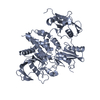 8rzwC  8rzyC 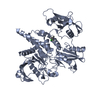 8s01C 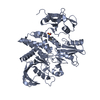 8s04C  8s06C  8s07C  8s0hC 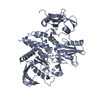 8s0jC 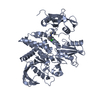 8s0kC  8s0oC  8s0pC 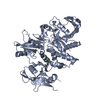 8s0qC  8s0sC C: citing same article ( |
|---|---|
| Similar structure data | Similarity search - Function & homology  F&H Search F&H Search |
- Links
Links
- Assembly
Assembly
| Deposited unit | 
| ||||||||
|---|---|---|---|---|---|---|---|---|---|
| 1 | 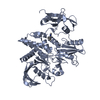
| ||||||||
| 2 | 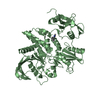
| ||||||||
| Unit cell |
|
- Components
Components
| #1: Protein | Mass: 61899.789 Da / Num. of mol.: 2 Source method: isolated from a genetically manipulated source Source: (gene. exp.)  Homo sapiens (human) / Gene: PTPN11, PTP2C, SHPTP2 / Production host: Homo sapiens (human) / Gene: PTPN11, PTP2C, SHPTP2 / Production host:  #2: Chemical | Mass: 194.232 Da / Num. of mol.: 2 / Source method: obtained synthetically / Formula: C13H10N2 / Feature type: SUBJECT OF INVESTIGATION #3: Water | ChemComp-HOH / | Has ligand of interest | Y | |
|---|
-Experimental details
-Experiment
| Experiment | Method:  X-RAY DIFFRACTION / Number of used crystals: 1 X-RAY DIFFRACTION / Number of used crystals: 1 |
|---|
- Sample preparation
Sample preparation
| Crystal | Density Matthews: 2.18 Å3/Da / Density % sol: 43.67 % |
|---|---|
| Crystal grow | Temperature: 293 K / Method: vapor diffusion, hanging drop / pH: 8 Details: 0.5M K formate 15% PEG 3350 0.1M pH=8 Bis-Tris propane/HCl |
-Data collection
| Diffraction | Mean temperature: 100 K / Serial crystal experiment: N |
|---|---|
| Diffraction source | Source:  SYNCHROTRON / Site: SYNCHROTRON / Site:  ESRF ESRF  / Beamline: ID29 / Wavelength: 0.96862 Å / Beamline: ID29 / Wavelength: 0.96862 Å |
| Detector | Type: DECTRIS PILATUS 6M / Detector: PIXEL / Date: Apr 21, 2016 |
| Radiation | Protocol: SINGLE WAVELENGTH / Monochromatic (M) / Laue (L): M / Scattering type: x-ray |
| Radiation wavelength | Wavelength: 0.96862 Å / Relative weight: 1 |
| Reflection | Resolution: 1.929→45.58 Å / Num. obs: 77010 / % possible obs: 96.6 % / Redundancy: 3.4 % / Rrim(I) all: 0.047 / Net I/σ(I): 11.8 |
| Reflection shell | Resolution: 1.929→1.97 Å / Mean I/σ(I) obs: 2 / Num. unique obs: 4165 / Rrim(I) all: 0.726 / % possible all: 89.4 |
- Processing
Processing
| Software |
| ||||||||||||||||||||||||||||||||||||||||||||||||||||||||||||||||||||||||||||||||||||||||||||||||||||||||||||||||||
|---|---|---|---|---|---|---|---|---|---|---|---|---|---|---|---|---|---|---|---|---|---|---|---|---|---|---|---|---|---|---|---|---|---|---|---|---|---|---|---|---|---|---|---|---|---|---|---|---|---|---|---|---|---|---|---|---|---|---|---|---|---|---|---|---|---|---|---|---|---|---|---|---|---|---|---|---|---|---|---|---|---|---|---|---|---|---|---|---|---|---|---|---|---|---|---|---|---|---|---|---|---|---|---|---|---|---|---|---|---|---|---|---|---|---|---|
| Refinement | Method to determine structure:  FOURIER SYNTHESIS / Resolution: 1.929→45.58 Å / Cor.coef. Fo:Fc: 0.95 / Cor.coef. Fo:Fc free: 0.943 / SU R Cruickshank DPI: 0.34 / Cross valid method: THROUGHOUT / σ(F): 0 / SU R Blow DPI: 0.166 / SU Rfree Blow DPI: 0.143 / SU Rfree Cruickshank DPI: 0.145 FOURIER SYNTHESIS / Resolution: 1.929→45.58 Å / Cor.coef. Fo:Fc: 0.95 / Cor.coef. Fo:Fc free: 0.943 / SU R Cruickshank DPI: 0.34 / Cross valid method: THROUGHOUT / σ(F): 0 / SU R Blow DPI: 0.166 / SU Rfree Blow DPI: 0.143 / SU Rfree Cruickshank DPI: 0.145 Details: HYDROGENS WERE FULLY REFINED WITH FULL OCCUPANCY AT NUCLEAR POSITION.
| ||||||||||||||||||||||||||||||||||||||||||||||||||||||||||||||||||||||||||||||||||||||||||||||||||||||||||||||||||
| Displacement parameters | Biso mean: 52.528 Å2
| ||||||||||||||||||||||||||||||||||||||||||||||||||||||||||||||||||||||||||||||||||||||||||||||||||||||||||||||||||
| Refine analyze | Luzzati coordinate error obs: 0.23 Å | ||||||||||||||||||||||||||||||||||||||||||||||||||||||||||||||||||||||||||||||||||||||||||||||||||||||||||||||||||
| Refinement step | Cycle: LAST / Resolution: 1.929→45.58 Å
| ||||||||||||||||||||||||||||||||||||||||||||||||||||||||||||||||||||||||||||||||||||||||||||||||||||||||||||||||||
| Refine LS restraints |
| ||||||||||||||||||||||||||||||||||||||||||||||||||||||||||||||||||||||||||||||||||||||||||||||||||||||||||||||||||
| LS refinement shell | Resolution: 1.93→1.94 Å / Total num. of bins used: 51
| ||||||||||||||||||||||||||||||||||||||||||||||||||||||||||||||||||||||||||||||||||||||||||||||||||||||||||||||||||
| Refinement TLS params. | Method: refined / Refine-ID: X-RAY DIFFRACTION
| ||||||||||||||||||||||||||||||||||||||||||||||||||||||||||||||||||||||||||||||||||||||||||||||||||||||||||||||||||
| Refinement TLS group |
|
 Movie
Movie Controller
Controller



 PDBj
PDBj










